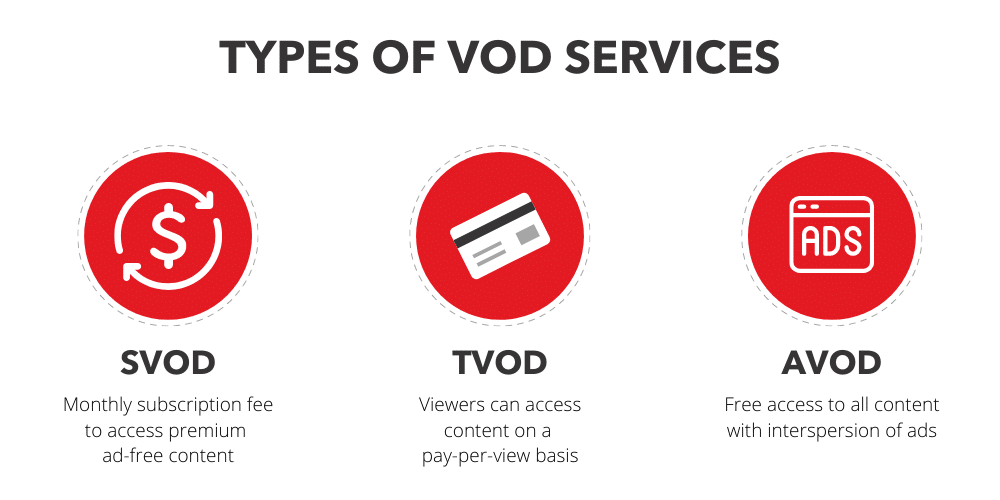Today we’re talking all about VOD business models. That’s video-on-demand, for you and me. VOD video services have become big business in recent years. Really, really big business. And Covid-19 has only furthered this global domination.
In 2021, revenue in the video-on-demand segment is projected to reach a staggering $85,887, according to research conducted by Statista.
And the market’s largest segment is the subscription video on demand (SVOD) model, which is expected to reach an annual growth rate of 10.17% and a projected market volume of $126,548 by 2025.
Now. If you’ve been doing your reading, you might have come to the realisation that SVOD isn’t the only VOD business model in town.
Yes- that’s right. We’ve got some more learning to do.
Best SVOD platforms is one of three video-on-demand models. But here’s the list of all the three VOD models:
- SVOD – subscription video on demand
- TVOD – transactional video on demand
- AVOD – ad-based video on demand
You’d be forgiven for thinking this all sounds like a lot of gobbledygook. But don’t worry. We’re going to be clearing up the issue and explaining the wonderful world of SVOD, TVOD, and AVOD, once and for all.
Sick of sifting through confusing web results? Looking for the answers all in one place?
If you’re thinking of launching your own video-on-demand service then listen up. Choosing the right monetization model is absolutely critical to success.
And key to making the perfect pick is doing a wee bit of research.
Luckily, this definitive guide will cover everything you need to know in order to make the best decision for your business.
So, sit back, relax, and get yourself one step closer to realizing your platform VOD goals.
VOD business models
Let’s start with a basic outline. First thing’s first. It’s time to get back to basics.
VOD stands for video-on-demand.
In 2021, most of us will be familiar with these platforms.
We’re talking about VOD streaming platforms just like Netflix and Hulu.
With video-on-demand services, we get to watch what we want, when we want, where we want.
But that’s not all there is to it. VOD isn’t a one-size-fits-all business model.
In fact, there are three main types of VOD that businesses can mobilize.
Let’s tale a look.
SVOD – subscription video on demand
SVOD (or simply Subscription VOD) is a video streaming service model that requires users to subscribe before they can access any content. In other words, users pay a subscription fee (usually monthly) in order to access content. If Netflix is on your mind- then you’re thinking just right. Netflix is, in fact, a subscription video on demand services.
Netflix users pay their monthly subscription and, in return, gain access to an unlimited library of video content. There is no cap on the amount of content consumed. Plus, contracts are highly flexible. Users won’t be locked into their commitment and are free to cancel any time.
SVOD examples include:
- Netflix
- Hulu
- Disney +
TVOD – transactional video on demand
TVOD is a pay-per-view on-demand content model. In other words, users are not charged to access the TVOD channel but are required to pay for the individual pieces of content they want to use. That could be a movie, TV-show, song, workout routine, educational lecture etc. Under a TVOD model, users can choose whether to ‘rent’ or ‘buy’ their chosen content.
TVOD examples include:
- Google Play
- iTunes
- Sky Box Office
AVOD – ad-based video on demand
AVOD is an ad-based video-on demand business model. And the best thing is hat AVOD platforms are completely free for consumers. Instead, the service provider monetizes their content via ad revenue. This is a bit more like traditional television, where advertisements are dispersed amongst video content. The difference is that AVOD platforms are entirely internet based.
AVOD examples include:
- YouTube
- Roku
- Tubi

Why should you start a SVOD business?
So, what’s the big deal with SVOD?
And why should your start a SVOD business of your own?
SVOD is the most common VOD service model. And it’s currently the most lucrative service model as well. Did you know that the majority of Americans are subscribed to Netflix? It’s true. According to research conducted by Forbes, a whopping 55% of Americans have a Netflix subscription. Coming in at a close second, 52% are of all Americans are using Amazon Prime Video.
So clearly SVOD is doing something right.
But why is this particular service model making strides above the rest?
Well, it all comes down to something called The Membership Economy. The Membership Economy defines those products and services that establish ongoing relationships with their clients over time. And that’s exactly what SVOD services like Netflix and Amazon Prime do.
SVOD benefits consumers who gain unlimited access to the content of their choice.
SVOD benefits businesses who gain a direct revenue line to their consumers.
And that’s exactly why you should be expanding your business with a SVOD applications right now. Don’t go thinking that SVOD is just for the big boys. Sure, Netflix and Amazon are the giants of the giants, but that doesn’t bar smaller businesses from profiting out of SVOD as well.
Subscription models can be highly lucrative for smaller VOD businesses as well. Whether you work in fitness, education, healthcare, or entertainment, SVOD can and will work for you. Think about all the client’s you’ll attract with an online fitness subscription service, for example?
The possibilities are endless.

SVOD pricing model
SVOD may be the clear winner in the video-on-demand ecosystem right now, but it doesn’t stop there. SVOD isn’t the final answer. In fact, there are numerous different ways to approach a subscription-video-on-demand model.
You’ve decided to adopt a SVOD model. That’s great. But now it’s time to choose a pricing model for your SVOD service. There are three main options when it comes to SVOD pricing. Let’s take a look.
The ‘free trial’ model
A free trial is a limited-time free service. Users will be able to access your entire library of content for free until their free trial is over. This is a great way to hook in new users. If they like your service offering, they’ll be more likely to subscribe once their trial is over. Many subscription-based models offer a free trial of some kind. For example, by offering a month of free video content, you’ll give prospective subscribers ample time to become invested in your platform.
The ‘freemium’ model
A freemium model offers users free services for an unlimited period of time. Sounds too good to be true right? But think about apps like Spotify, for example. Spotify does just this. Users can use the platform as and when they please, free of charge. Monetization occurs when users upgrade to paid plans. So, it’s important to keep them wanting more for your freemium offering to work long-term.
The ‘varied access’ model
The varied access model offers the most choice. Under the varied access model, users are offered a variety of access options. Users pick a subscription plan that works best for them. There are tons of different options under this model. For example, you might charge users more for unlimited screen access, data usage, or additional monthly downloads.
It’s important to pick the pricing model that works best for your business. If you’re just starting out a free trial model is a great idea. An education portal, for example, might offer a month of free online lessons and lectures to new users. The idea being, that when users uncover the valuable content on offer, they will choose to join as a paying subscriber.
And there’s nothing stopping you from adopting multiple payment models. In fact, numerous VOD services are doing this already. Take Amazon Prime Video, for example. Subscribers get access to a main library but new movie releases are also showcased for an additional pay-per-use charge.
How can your business implement SVOD?
It’s implementation time!
To launch your very own SVOD platform, you’ll need to plan, develop, and launch your app to the public. And key to that is doing your research first.
Here’s a step-by-step guide to help you get started.
Step 1: research your niche
First thing’s first, make sure you know your target user inside out. Who are you marketing your content to? Are you an educational content provider targeted at school-age children? Are you a fitness instructor who wants to reach out to stay-at-home parents? Whatever your niche, identify it and target every aspect of your platform to those all-important target personas.
Step 2: choose your tech stack
Pick your tech. Will you be using a business SVOD service provider and app builder, or are you planning to hire a third -party app developer to build you a fully customized SVOD platform? Either way, make sure you know what features you’ll need on your platform. Possible features to consider, include paywalls, log-in entry, and multiple user profiles.
Step 3: identify a pricing plan
Choose your pricing plan. Will you issue a free trial or are you going freemium? Remember you are selling content here. And, depending on the nature of your content, you’ll need to pick a pricing model that will appeal to your target users.

Examples of SVOD businesses
You’re almost ready to go out there and launch your very own SVOD platforms. But, before you do, here are some examples to spark a little bit of extra inspiration.
We’ve all heard of Netflix- the golden child of video-on demand services.
But Netflix isn’t the only SVOD service doing good work right now.
SVOD is as much for niche channels as it is for the mainstream giants. So, here’s a list of some of our favorite SVOD channels striving ahead in the industry right now.
Cruncyroll – the independent video content provider
Crunchyroll are tapping into a growing demand for Anime in the US. This SVOD business offers its users niche video content with a particular focus on Anime, Manga, and Dorama.
Adventure Sports TV – for niche-sport related content
Adventure Sports TV is a video streaming service dedicated to unique sports-related content, including sporting documentaries covering extreme and endurance sports.
Kanopy – for educational films and documentaries
Kanopy is an education content streaming service which provides a library of educational films and documentaries that students can access on their smartphones, laptops, and other devices.
Peloton -for the best spin classes from your own home
Peloton is an exercise-based SVOD business which provides spinning classes online. As well as the video subscription itself, Peloton also sells an interactive stationary bike from which users can take part in live spin classes with real-time instructors and fellow participants.
FAQs
What does SVOD stand for?
SVOD stands for Subscription Video on Demand app
What is SVOD vs AVOD?
SVOD users pay a recurring subscription fee to watch unlimited content from a video-on-demand platform. AVOD users do not have to pay to watch content. Instead, the VOD service monetizes their content via advertising revenues.
What is the difference between SVOD and TVOD?
Whilst SVOD users pay a recurring subscription fee in exchange for unlimited content access, TVOD users do not pay a regular subscription but, instead, pay-per-view. For example, a user will pay to rent or buy access to a particular video.
Is Netflix SVOD?
Yes, Netflix runs under a SVOD model. This is the standard subscription-based model in which subscribers pay a monthly access fee to watch Netflix content.
Give SVOD the nod
Video-on-demand has made great strides in recent years. More and more consumers want to be able to consume their media at convenience. And up to this point subscription-based models (or SVOD) are proving the most lucrative platforms. As this space becomes ever more competitive, it’s time to make your mark in the SVAD space.




